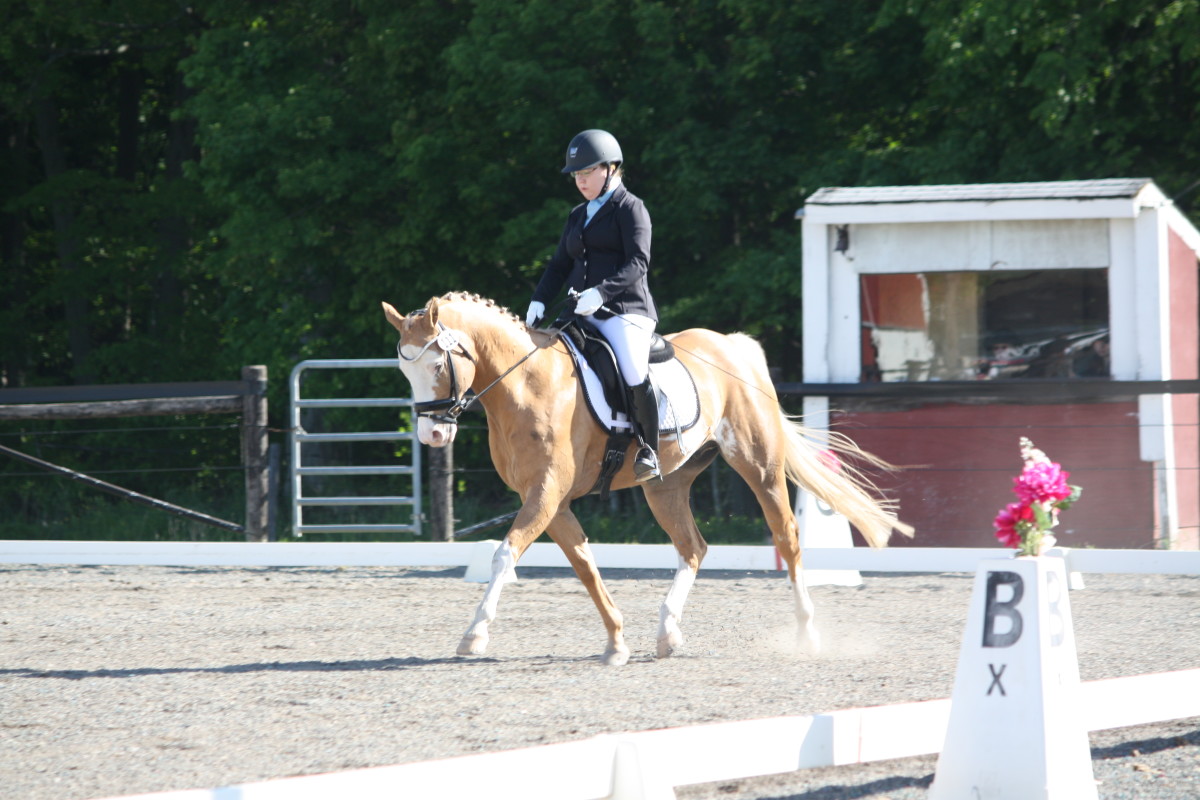
This picture shows Alexandria Belton competing her 17-year-old American Paint gelding, Daffy’s Son Shine (“Coqui”). Alexandria writes that she is successfully competing at Second Level and is schooling Third Level at home with the goal of earning her scores for her USDF bronze medal. According to Alexandria, Coqui had only been ridden in reining, cattle work, jumping and Western pleasure until he was 10 years old. Then she introduced him to dressage and now they’re working their way up through the levels. This is a good example how the classical, correct riding system allows horses of all types and ages to be worked correctly and stay healthy and athletic in their movement.
In her note, Alexandria very accurately describes that it is now difficult to work on further collection and more lightness of the shoulders as her horse is, by nature, bred and built more downhill. She also reports that for her, too, it is hard to keep her shoulders back and that she has the habit of looking down.
I often notice that there are similarities between horse and rider. So it does not surprise me that Coqui and Alexandria are both showing this weak spot around their shoulders. Alexandria correctly describes this challenge and asks for help in addressing it.
Helping a horse to become lighter in the forehand needs a lot of support and stability of the rider’s upper body.
When looking at the picture, I notice that Alexandria is riding with a nice long leg position and it seems to be only up between her shoulders that she rounds. She looks down a bit and, as a result, her arms are not carried enough forward.
Sometimes one can build up support and strength in the back by slightly rounding the shoulders and keeping the upper arms and elbows a bit to the outside. This creates some stretch over the back and shoulder area and that can help for a better connection with the horse. However, this rounding creates fake stability and will only work in the short term. When such a rider tries to correct the round shoulder position and pulls her shoulders back and down, she often becomes unstable in the core and lacks feel for her horse’s needs and then the picture becomes more stiff than stable.
Instead of focusing on bringing her shoulders back, I would advise Alexandria to concentrate more on the movement of her spine. Try this: Sit on a chair and feel your collarbones all the way from your sternum to the sides of your shoulders. Then you should feel down the vertebrae of your neck and feel the one bone sticking out of the back of the neck the farthest. This is the lowest cervical segment, called C7. To mobilize your upper thoracic spine, you should imagine a movement of rounding your spine by letting the collarbones move down while the C7 vertebra pushes up. Then arch your upper spine by lifting your collarbones up as C7 moves down. This can be a very tiny movement, but it has great influence on your head and shoulder position and your influence of the horse.
Often when we attempt to sit up straight, we only lift our chins and, by that, we shorten the back of our necks, which is not healthy. Then we become stiff in the shoulders by holding them back, which means we are unable to keep a soft, giving and elastic contact with the horse’s mouth. Instead of straightening in the upper part of the spine, we move the lower ribs forward and we lean back. This stiffens the lower back and prevents us from following the horse’s movement smoothly.
The exercise I described teaches a different approach to straightening up in the body and connects the rider more with the seat, leaving her shoulders free and independent. Instead of forcing the shoulders back, the chest moves forward up between the shoulders and this allows more suppleness combined with a more stable core.
I describe this in detail because this will become the key for Alexandria to bring Coqui into a higher level of collection. Playing between a tiny curl and arch movement will open new refined levels of communication between her and her mount. Once she gets this feeling, her habit of looking down will fade out of her riding automatically. I wish Alexandria and Coqui luck and success on their way up to Third Level!
Susanne von Dietze is a leader in equestrian biomechanics. A physiotherapist, licensed Trainer A instructor and judge for dressage and show jumping, she gives lectures and seminars throughout the world, including at the prestigious German Riding Academy in Warendorf. She is a native of Germany and now lives with her husband and three children in Israel, where she competes at the international level. She is the author of two books on the biomechanics of riding: Balance in Movement and Horse and Rider, Back to Back. Find her books at www.EquineNetworkStore.com.











